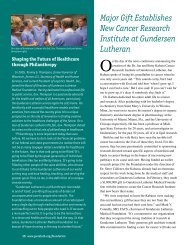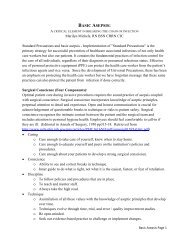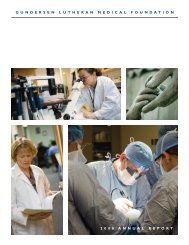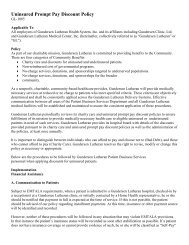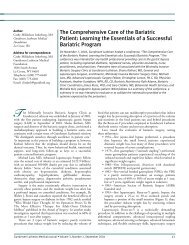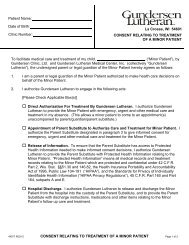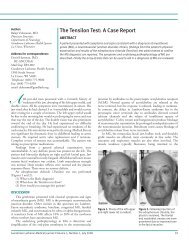Goals & Objectives Past and Present Issues of Infection Control ...
Goals & Objectives Past and Present Issues of Infection Control ...
Goals & Objectives Past and Present Issues of Infection Control ...
Create successful ePaper yourself
Turn your PDF publications into a flip-book with our unique Google optimized e-Paper software.
Name: ______________________________Department/Institution:____________________________<br />
Immunology<br />
Contact hours – 1.25<br />
<strong>Goals</strong> & <strong>Objectives</strong><br />
<strong>Goals</strong><br />
To improve the learner's underst<strong>and</strong>ing <strong>of</strong> how immunology relates to infection control.<br />
<strong>Objectives</strong><br />
• Briefly describe immunology <strong>and</strong> related terms.<br />
• Briefly describes how the immune system works.<br />
• Interpret common reports from the Immunology lab.<br />
Test<br />
1. Immunology<br />
a. Is the study <strong>of</strong> reactions by a specific group <strong>of</strong> antigens introduced by a nutrient.<br />
b. Is the limited study <strong>of</strong> an inflammatory response following tissue damage.<br />
c. Is the study <strong>of</strong> all aspects <strong>of</strong> the immune system including its structure <strong>and</strong><br />
function, disorders <strong>of</strong> the immune system, blood banking, immunization <strong>and</strong><br />
organ transplantation.<br />
d. All <strong>of</strong> the above<br />
2. An antigen is<br />
a. A familiar cell within the body.<br />
b. Part <strong>of</strong> the humoral acquired immunity.<br />
c. A foreign invader.<br />
d. Part <strong>of</strong> the specific immune system that is derived from the B lymphocytes.<br />
3. The immune system is<br />
a. A complex network <strong>of</strong> specialized cells <strong>and</strong> organs whose primary job is to<br />
protect us from foreign invaders through our innate <strong>and</strong> acquired immunity.<br />
b. Derived from the thymus, bone marrow, spleen, lymph nodes, tonsils, appendix,<br />
Peyer’s patches <strong>and</strong> MALT.<br />
c. Primarily dependent on B lymphocytes <strong>and</strong> T lymphocytes for specific immunity.<br />
d. All <strong>of</strong> the above.<br />
4. T lymphocytes originate from the hematopoietic stem cells but migrate to the thymus<br />
<strong>and</strong><br />
a. Some may eventually evolve into the T helper cell (CD4) which secretes<br />
cytokines when activated<br />
b. Some may eventually evolve into the T cytotoxic cell (CD8) which destroys<br />
virally infected cells.<br />
c. Only the T cells can recognize antigens originating from the cells within the host.<br />
d. All <strong>of</strong> the above.<br />
- 30 -








